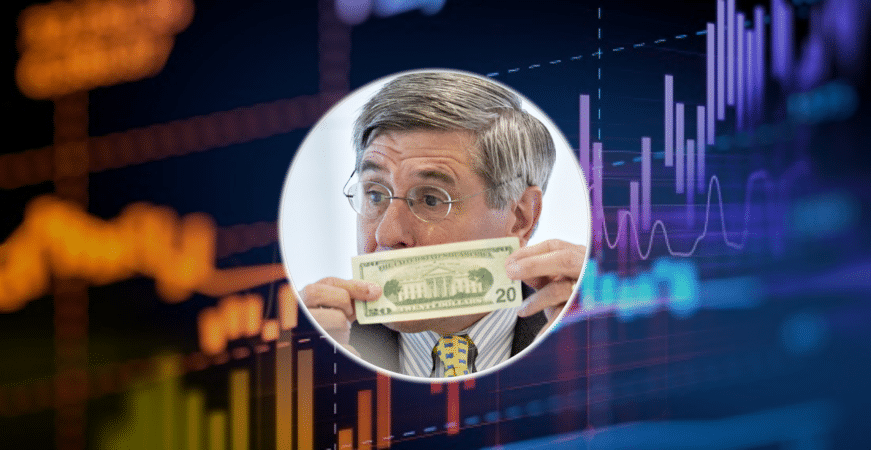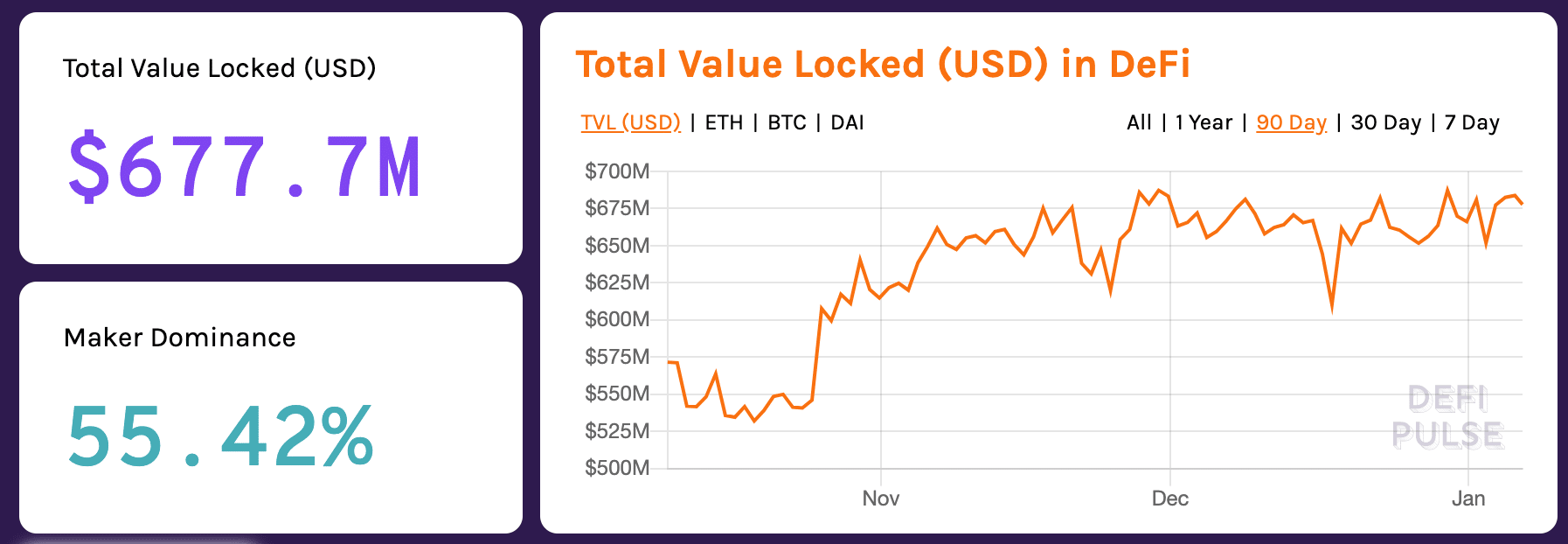- What does the role of Chief Economic Officer at a cryptocurrency project look like?
- What’s it like being a proponent for blockchain and digital assets in Trump’s administration?
- Will cryptocurrency be a topic for future Presidential elections?
- Why does the world need another stablecoin?
- What are your plans for user adoption? What does the stablecoin need to succeed?
- What’s in it for you guys?
- Why peg Frax to the Dollar?
- Hypothetically, can Frax be shut down?
- How will governments react to a widely adopted stablecoin?
- Is stability necessarily always a good thing?
- Final Thoughts
There’s at least one blockchain bull in Washington D.C.
Stephen Moore currently serves as Donald Trump’s senior economic adviser. Moore played an instrumental role in the writing and passage of the Tax Cuts and Jobs Act (2017) and briefly entertained a Trump nomination to serve as a governor of the Federal Reserve and help manage the nation’s currency (Moore would withdraw his name from consideration.)
Moore, a self-ascribed policy geek, counts over 35 years of working in public policy. During this time, Moore was also on the Wall Street Journal editorial board, Fox News Channel, and CNN as a senior economic analyst.
Worth Magazine ranked Moore as the 32nd most powerful person in global finance. In 2018, Moore met the Founder and CEO of Frax (then Decentral Bank) Sam Kazemian at the SALT conference, a bi-partisan investment conference hosted by Former White House Director of Communications Anthony “The Mooch” Scaramucci. Kazemian is the co-founder of Everipedia, a for-profit Wikipedia “fork” that uses the EOS blockchain and incentivized content creation using a cryptocurrency token called IQ.
Today, Moore serves as the Chief Economic Advisor of Frax, a decentralized fractional-reserve-based stablecoin. By its nature, Frax will compete with central banks by offering a stable digital alternative.
We connected with Moore and Kazemian to discuss the future of stablecoins, the current political climate surrounding blockchain and bitcoin, and how the Frax team aims to establish Frax as a widely adopted digital asset.
What does the role of Chief Economic Officer at a cryptocurrency project look like?
Moore has spent the bulk of his career advising politicians and rallying stakeholders in advocacy of lower taxes and decreased government spending. As a senior economic advisor to Trump, Moore helped work on overhauling the US tax policy, which was passed into law by Congress in 2017.
Today, Moore is dedicated some of his schedules to something out of the immediate wheelhouse of most in Washington: advising a blockchain startup on its creation of a stablecoin.
“One of my roles is to make sure Frax grows and grows into billions of dollars but keeps a stable value,” says Moore.
Moore also wants to help Frax escape and better navigate a murky regulatory atmosphere.
“Another role is to help the company navigate this undefined regulatory climate,” says Moore. “We don’t know what regulations are coming but we know there are regulations coming. It’s not much an economist role but I’ve been in Washington for 35 years and I know how these agencies work. Regulatory agencies might try to slam the door shut on a lot of these cryptocurrencies and we want to find a way to prevent these currencies from being shut down.”
What’s it like being a proponent for blockchain and digital assets in Trump’s administration?
“Trump administration has had some skepticism,” comments Moore. “Not hostility, but skepticism. We want to work with the administration and ease some of their fears. Stablecoins and blockchain are not something that will blow up the economy. It should be viewed as an asset or a liability.”
“People inside the Trump administration are intrigued. One role I’ve helped play is to increase the visibility of blockchain and digital assets. They raise objections and complaints, and I try to talk them down from the ledge. I view this as the Internet age where the government can’t stop progress. I think crypto and digital currencies are the next big thing.”
“You can’t stop technology. Let it proliferate, let people use it, and let it become the Wild West. It would be very advisable for the Trump administration to let people work this out and make their own decisions. Regulators are trying to solve yesterday’s problem and far away from the curve of solving where the best things are.”
“Early adopters will realize its potential. We’re at a stage where 95% of people probably don’t know what it is.”
Will cryptocurrency be a topic for future Presidential elections?
“2020 no,” comments Moore. “2024 yes”
Why does the world need another stablecoin?
Frax differentiates itself from other stablecoins as an algorithmically managed reserve of cryptocurrency and digital bonds.
“We’d like other stablecoins to continue growing so we can use them as collateral to back Frax,” notes Kazemian. “We’re not another Tether or Maker clone that over-collateralized Ether.”
But why now? Kazemian looks at the industry’s progress in the past few years as extremely productive in setting the foundation for decentralized finance.
“I don’t think something like Frax would have been possible until the industry grew into what it is today,” says Kazemian. “Money markets like compound.finance have hundreds of millions of loans coming in. People are paying interest on those products. Tether and Dai getting a strong foothold. Tether is the fifth-largest cryptocurrency by market cap. Also, the psyche in the industry has changed that stablecoins are an important part of the ecosystem. We needed the whole atmosphere to change.”
There is nearly $700 million locked in loans locked in decentralized finance (DeFi) contracts.
“To me, Bitcoin isn’t really a currency; it’s a commodity,” says Moore. “A speculative commodity at that. I’m not saying that to be negative. A currency retains its value over time without going way up and down in value.”
“A recession or a bear market is just a bull market for stability,” says Kazemian. “What happens when prices go down? Everything flees for the dollar. Just by logic, when there’s a bear market on one end, there’s technically a bull market for what the assets are priced in. It just makes sense. We’re seeing the same thing in crypto. Seeing utility coins and shitcoins plummet, and stablecoins like Frax are there to give investors stability and sound value.”
What are your plans for user adoption? What does the stablecoin need to succeed?
“We view it as a multi-layered approach,” says Kazemian. “In order for Frax to grow, it needs institutional or exchange backing so people can actually use it. The second phase is once people can get access to Frax, we’ll start figuring out how to get out to the general public. We’re looking into more retail-based things like Robinhood or Cashapp and slowly move into the consumer space.”
What’s in it for you guys?
“With most decentralized coins, there’s a 2 token system,” comments Kazemian. “People who want exposure to growth hold the volatile token. Frax works the same way. Frax shares (FXS), those tokens are hopefully going to be worth a lot. They work in a similar way. The total value of frax shares is the DCF [discounted cash flow] of all fees paid in Frax. Part of the shares has value in the entire system. It’s pretty exciting because it’s like having shares in a decentralized central bank. The original shares generated are distributed to the founding team and investors, partners– similar idea to MakerDao token.”
Much of Moore’s blockchain support seems to be rooted in his strong Libertarian leanings.
“I want the government to know as little about me as possible,” says Moore. “I think millions of people are like me around the world. The idea you can have a currency that’s not monitored or controlled by the government is very valuable. You can’t discount the value of a decentralized currency.”
Why peg Frax to the Dollar?
“If the value of the USD changes, we’d have to wonder about how to update the protocol to follow another peg,” says Kazemian. “It’s possible in terms of software. I can’t see a world where the USD doesn’t lose its value.”
“This is a great question,” says Moore. “Is the dollar the best thing to peg this to? There are flaws in many currencies. I lived through the 70s where we saw 15% rates of inflation. What else would you want to peg it to? One idea we thought about was pegging it to the price of gold, but it fluctuates more than the dollar. Many currencies have had much bigger peaks and values over time. It’s the best choice out there. The Dollar is simply the least rotten apple in the bunch”
The team sees Frax co-existing and even supporting the U.S. Dollar.
“Frax helps solidify the dollar’s role as the world currency,” comments Moore. “We see Frax as a digital world reserve currency.”
“Since Frax is pegged to the U.S. dollar, it’ll help keep it relevant,” says Kazemian. “You can move the same dollar value using a blockchain infrastructure. We’re not trying to do a weird floating currency like Libra that has a unique exchange rate to the USD. We’re actually excited because it’s a very American project.”
Hypothetically, can Frax be shut down?
“There’s nothing illegal about what we’re doing,” comments Moore. “There would be a lot of problems for the government trying to shut down. It’s a legal product. Government regulators recognize it’s a clear and present danger to their current status. They will try to figure out a way to slow it down. Government regulators, especially when it comes to technology, are always like three chess moves behind the industry.”
“In a hypothetical world, it’s a decentralized financial product,” adds Kazemian. If they try to take out Satoshi after they release code, people are already running it.”
In other words, once the cat is out of the bag, you can’t put it back in.
How will governments react to a widely adopted stablecoin?
According to Moore, stablecoins can serve as an important policy function that isn’t recognized by the people in policy powerhouse cities like Washington, Brussels, Tokyo, and so on.
“These cryptocurrencies will have a very disciplining effect on government currencies,” comments Moore. “As Sam was saying, there’s a saying good money drives out bad money. People are going to flow to the currency they trust. People flee to the dollar, which forces other countries to think twice about devaluing their currency.”
The large number of viable substitutes that exist, the less likely governments will be able to manipulate their currencies outside of the best interest of the public.
“When countries get into a debt crisis, they try to depreciate the debt currency and then try to pay back debtors,” explains Moore. “It’s a way of screwing over the debtors. Now, when you’re going to have currencies like Frax out there, you’re going to see a migration to more transactions being done in Frax instead of itself.”
The availability of substitutes such as Frax and other stablecoins is going to make it difficult for central bankers to successfully inflate or deflate a country’s currency.
“It’s going to force central bankers that they will have to keep their currencies stable. Markets will instantly punish them for not. Over time, you can see some of these debts paid back in Frax instead of a certain currency.”
Is stability necessarily always a good thing?
“Stable currency is optimal,” says Moore. “You always want your currency to be level in value. We know from history for hundreds of years, high inflation and high deflation can have negative consequences for an economy. It gets back to Economics 100: why do you have a currency in the first place. If it doesn’t retain its value, people will use other things to trade with.”
Final Thoughts
To learn more about Frax, check out the first version of the whitepaper on Frax.finance. Currently, the team is testing some of the smart contract features on EOS and planning Ethereum integration.
It’s estimated Frax will be available on the market at some point in 2020.
Never Miss Another Opportunity! Get hand selected news & info from our Crypto Experts so you can make educated, informed decisions that directly affect your crypto profits. Subscribe to CoinCentral free newsletter now.











